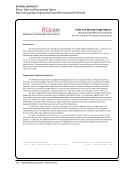SPEC Kit 329: Managing Born-Digital Special Collections and Archival Materials · 131
University of Michigan
Sustainable Formats and Conservation Strategies at the BHL
http://bentley.umich.edu/dchome/resources/BHL_PreservationStrategies_v01.pdf
11/9/2011 2
Tier 2: Conversion of At‐Risk Formats
The digital curation community has long acknowledged the disadvantages posed by
proprietary formats (for which only specific software may be used) and content encoded
with "lossy" compression (i.e. compression that reduces the quality of the data to conserve
space). The Bentley Historical Library will therefore convert the most common at‐risk
formats to preservation‐quality sustainable formats. To ensure the authenticity of
materials, the original version will be maintained alongside the preservation copy.
See pp. 3‐5 for a list of at‐risk formats and preservation targets these strategies reflect the
policies and practices of peer institutions as well as the National Digital Information
Infrastructure and Preservation Program. Visit the Library of Congress “Sustainability of
Digital Formats” site (http://www.digitalpreservation.gov/formats/index.shtml) for more
information on preservation issues and descriptions of preferred formats.
Tier 3: Bit‐Level Preservation of All Other Formats
Because it is infeasible to create conversion plans for the tens of thousands of formats in
existence, the Bentley Historical Library will ensure that digital holdings in other formats
(i.e. ones not specifically identified in this document) will receive bit‐level preservation.
The use of integrity checks and regular replacement of storage media (conducted by
trusted partners in the University of Michigan Library Information Technology division and
Information and Technology Services) will preserve the raw data stored in these files (i.e.
the "stream" of 0s and 1s) in its original state. The library concedes that hardware or
software obsolescence may reduce the functionality of these files or render them
inaccessible. At the same time, the faithful preservation of the content at the bit‐level will
allow the library to take advantage of future developments in emulation technology.
University of Michigan
Sustainable Formats and Conservation Strategies at the BHL
http://bentley.umich.edu/dchome/resources/BHL_PreservationStrategies_v01.pdf
11/9/2011 2
Tier 2: Conversion of At‐Risk Formats
The digital curation community has long acknowledged the disadvantages posed by
proprietary formats (for which only specific software may be used) and content encoded
with "lossy" compression (i.e. compression that reduces the quality of the data to conserve
space). The Bentley Historical Library will therefore convert the most common at‐risk
formats to preservation‐quality sustainable formats. To ensure the authenticity of
materials, the original version will be maintained alongside the preservation copy.
See pp. 3‐5 for a list of at‐risk formats and preservation targets these strategies reflect the
policies and practices of peer institutions as well as the National Digital Information
Infrastructure and Preservation Program. Visit the Library of Congress “Sustainability of
Digital Formats” site (http://www.digitalpreservation.gov/formats/index.shtml) for more
information on preservation issues and descriptions of preferred formats.
Tier 3: Bit‐Level Preservation of All Other Formats
Because it is infeasible to create conversion plans for the tens of thousands of formats in
existence, the Bentley Historical Library will ensure that digital holdings in other formats
(i.e. ones not specifically identified in this document) will receive bit‐level preservation.
The use of integrity checks and regular replacement of storage media (conducted by
trusted partners in the University of Michigan Library Information Technology division and
Information and Technology Services) will preserve the raw data stored in these files (i.e.
the "stream" of 0s and 1s) in its original state. The library concedes that hardware or
software obsolescence may reduce the functionality of these files or render them
inaccessible. At the same time, the faithful preservation of the content at the bit‐level will
allow the library to take advantage of future developments in emulation technology.










































































































































































































